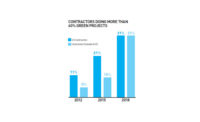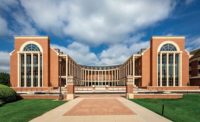New Research Reveals the Safety Hazards of Green Building
“Right now we’re trying to understand where the leverage points are within the rating system for opportunities that will allow us to make it better,” says Owens. “If we can become better informed about risks involved, we can improve the requirements of the rating systems and enhance safety. This study is an initial step in that direction.”
Whether the findings of this study have surprised or validated opinions of individuals around the industry, Owens asserts that the information is useful for everyone to consider. “I really hope that people will be looking at this study and learning from it. That’s certainly what we’ll be doing.”
Katie Frasier is a freelance construction writer and social media specialist in charge of promoting jobsite safety. She has a background in magazine journalism and has previously written for a number of national publications. Reach her at Workboots.com <workboots.com> or e-mail: Katie@cat5.com.
Sidebar: Examples of Identifying and Reducing Risks
In addition to identifying the increased risks in building for LEED certification, Hallowell and his team followed up with a study (due to publish in February) that found suggested mitigations for the added risks. It’s important to note that though these are listed under the LEED credential the construction methods meet, many of these risks are not unique to green building. Prevention efforts can also be applied to construction of traditional buildings that might incorporate one or more of these elements.
LEED Credit: Brownfield Redevelopment
Identified Risk: Extensive earthwork operations create a higher risk of falling or collapsing and hazards from the disposal of contaminants.
Suggested Mitigation: Workers could use impermeable plastic liners in the beds of heavy equipment and thoroughly wash all equipment at the end of each workday to reduce contamination.
LEED Credit: Stormwater Quality Control
Identified Risk: Workers have an increased risk of falling from increased excavation and trenching.
Suggested Mitigation: Designing detention ponds with gradual slopes to avoid steep embankments may help reduce risk of falling. Contractors could plan concurrent tasks away from the excavation.
LEED Credit: Heat Island Effect—Roof
Identified Risk: White roofing options can be heavier and slipperier than traditional black roofing material, which increases the risk for overexertion and falls. The bright material can interrupt line of sight and increase the risk of slips and falls during installation.
Suggested Mitigation: Tan or light gray membranes could be used to decrease reflectivity, or contractors could require tinted eyewear. Rubber walkpads could be provided for added traction, and contractors could purchase a greater number of smaller rolls to avoid overexertion from weight.
LEED Credit: Innovative Wastewater Technologies
Identified Risk: Risk of exposure to hazardous chemicals comes from construction a dual waste water system from installing additional piping.
Suggested Mitigation: Contractors might require non-polyester gloves and respiratory protection and employ extensive quality-control measures.
LEED Credit: Optimize Energy Performance
Should the LEED framework be held responsible for safety issues? No, LEED is simply a tool used to measure and verify green building performance. There are other organizations that are...
Do we have a concern about new green building systems and the safety of our workers at Sellen Construction? Absolutely! Any time you initiate a new construction practice or building system, it introduces tradespeople to new situations and there is the potential for a higher risk of incident. For example, with the increased use of vegetated roofing systems, landscapers (not typically expected to work on roofs) are being asked to install roofing systems which in turn, creates the need for heightened safety protocols and worker education.
Sellen Sustainability, the national training and consulting arm of Sellen Construction, is currently working on a Safety & Health Investment Project (SHIP) grant through Renton Technical Colleges Construction Center of Excellence to be used across Washington State. Funded by the Department of Labor & Industry, the SHIP grant will result in the creation of an industry-specific instructional video and an 8 hour course focused on training safety professionals. The goal is to help them acquire a core understanding of sustainable construction practices and green building systems in order to develop appropriate safety protocols to reduce incident rates associated with hazards such as falling, being struck by an object and overexertion.
Our training does not use a LEED credit specific approach; rather, in developing curriculum, our focus has been on new green building systems and practices that have safety implications as these issues also often occur on non-LEED projects and most builders do not think about construction and or safety from a LEED credit perspective. Our curriculum also includes a section on how LEED and basic green building practices actually protect workers. For example, we have a company-wide approach to indoor air quality management that significantly reduces workers exposure to potential trip hazards and known toxins through sustainable housekeeping, source control, pathway interruption, and the use of low-emitting adhesives, paints and sealants.
Safety statistics are an important first step to help raise awareness about the importance of safety professional training related to new green building practices. As such, we are focused on creating behavior change to reduce injuries, while maintaining the integrity of the green building industry.
Yancy Wright
Director, Sellen Sustainability






